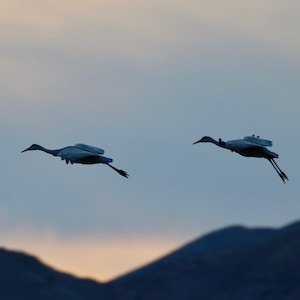
Integrating Artificial Intelligence and Thermal Imagery to Streamline Wildlife Monitoring
Research Location:
Implemented: Grand Island, NE, USA
Conservation Partners:
U.S. Fish and Wildlife Service and U.S. Geological Survey
Student Researcher (2024)
Andrew Lee, Major: Data ScienceStudent Researcher (2021 and 2023)
Emilio Luz-Ricca ‘23, Major: Data Science; Minor: Economics
Faculty Mentors
Dr. Robert Rose and Dr. Gregory HuntProject Description
W&M students are working with US Fish and Wildlife, US Geological Survey, and partners to develop a streamlined methodology using remote sensing and deep learning approaches to improve the efficiency of monitor sandhill crane populations to guide management and policy.
Streamlining and automating systems for monitoring wildlife populations is critical for informing and evaluating conservation management and policy. Given the rapid changes in climate, land development, and wildlife habitat, there is a need to streamline wildlife population monitoring in order to guide conservation action and management.
The combination of very high-resolution aerial remote sensing and deep learning techniques has the potential to provide an automated, efficient means to achieve these survey goals. As part of an ongoing collaboration, W&M students are working with the U.S. Fish and Wildlife Service (USFWS) Division of Migratory Bird Management, U.S. Geological Survey (USGS), and partners to develop a streamlined methodology that utilizes deep learning to identify sandhill cranes from thermal imagery to improve the efficiency and effectiveness of USFWS monitoring and management strategy.
In 2022, Emilio Luz Ricca '23 developed the first deep learning model that explored scale and other factors needed to ensure the model was effective in meeting partners' needs. Building upon this research, Andrew Lee '25 will scale the models, apply these techniques to a comprehensive dataset, and solve challenges, such as the detection of non-target species and dealing with large datasets, with the AI algorithms to improve their efficiency and utility for USFWS.
The aim is to apply this updated deep learning methodology to conduct the first complete survey of roosting sandhill cranes on the Platte River and will show how these innovative surveys can be accomplished.
Project ID - Format
21-012-21- CRP Year
21-012-23 - CRP Semester
21-012-24 - CRP Year














